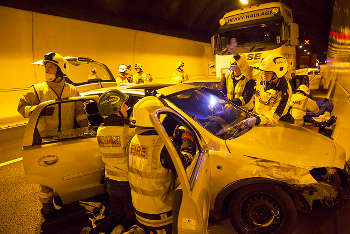Highways England has set out how it will spend £150m on innovation, including radar technology and road condition sensors.
The company has published its Innovation Strategy, which sets out for the first time its plans ‘to ensure it is keeping pace with advances in technology’.
According to the strategy, the Innovation Designated Fund, which will provide a ring-fenced £150m for innovation capital projects between now and 2021, ‘will deliver a step change in how we demonstrate and implement emerging technologies, new materials, and ways of working’.
Highways England chief executive Jim O’Sullivan said: ‘We’re committed to using innovation to benefit the millions of journeys made on England’s Strategic Road Network today and in the future.

An exercise in the A3 Hindhead Tunnel, which will now trial radar
‘We will work with our partners in the supply chain, technology specialists and the automotive industry to trial new technologies that will help make journeys on our roads safer, more reliable and better informed.’
The strategy appears to dilute some announcements from last month’s Budget. Where the Treasury said ‘the government will conduct trials of driverless cars on the strategic road network by 2017’, the strategy now says: ‘We will seek to trial autonomous vehicles on our network by the end of 2017.’
Highways England will also join 'a trial that would see information sent wirelessly to specially adapted vehicles on the A2/M2 between London and Kent'. On-road technology will wirelessly transmit journey information to vehicles which could suggest changing lanes or taking an alternative route.
The Budget documents had said the Government would 'establish' a connected corridor that would see vehicles 'communicate wirelessly with infrastructure and potentially other vehicles’.
A Highway England spokesman told Transport Network that the trial, which would include the Department for Transport, Kent County Council and Transport for London, as well as vehicle manufacturers, could still involve communication between vehicles.
Highways England will also trial radar technology on motorways and in tunnels to improve the way breakdowns are detected, beginning with the Hindhead Tunnel on the A3 in Surrey. The technology would continually monitor traffic and notify control centres within seconds of a stationary vehicle.
Under the strategy, the company will also look at improving the signalling of junctions on motorways to increase traffic flows. This would involve adapting timing of the signals at junctions, depending on the time of day and use.
It will also develop the use of ‘expressways’ on A-roads to encourage more free-flowing traffic by having modernised junctions, providing emergency refuge and maintenance areas and using advanced technology to provide journey information.
Highways England also says it will use innovation to deliver ‘improved management of our network and infrastructure assets’.
It will investigate the use of sensors that could provide better information about the condition of roads, bridges and tunnels on the network, which could in future allow for more targeted maintenance programmes.
Additional funding for innovation will be provided by the company’s research and development programme. One of the less tangible ideas in the strategy is ‘Exploring the creation of a Test and Innovation Centre to pioneer new research’.
Register now for full access
Register just once to get unrestricted, real-time coverage of the issues and challenges facing UK transport and highways engineers.
Full website content includes the latest news, exclusive commentary from leading industry figures and detailed topical analysis of the highways, transportation, environment and place-shaping sectors.
Use the link below to register your details for full, free access.
Already a registered? Login